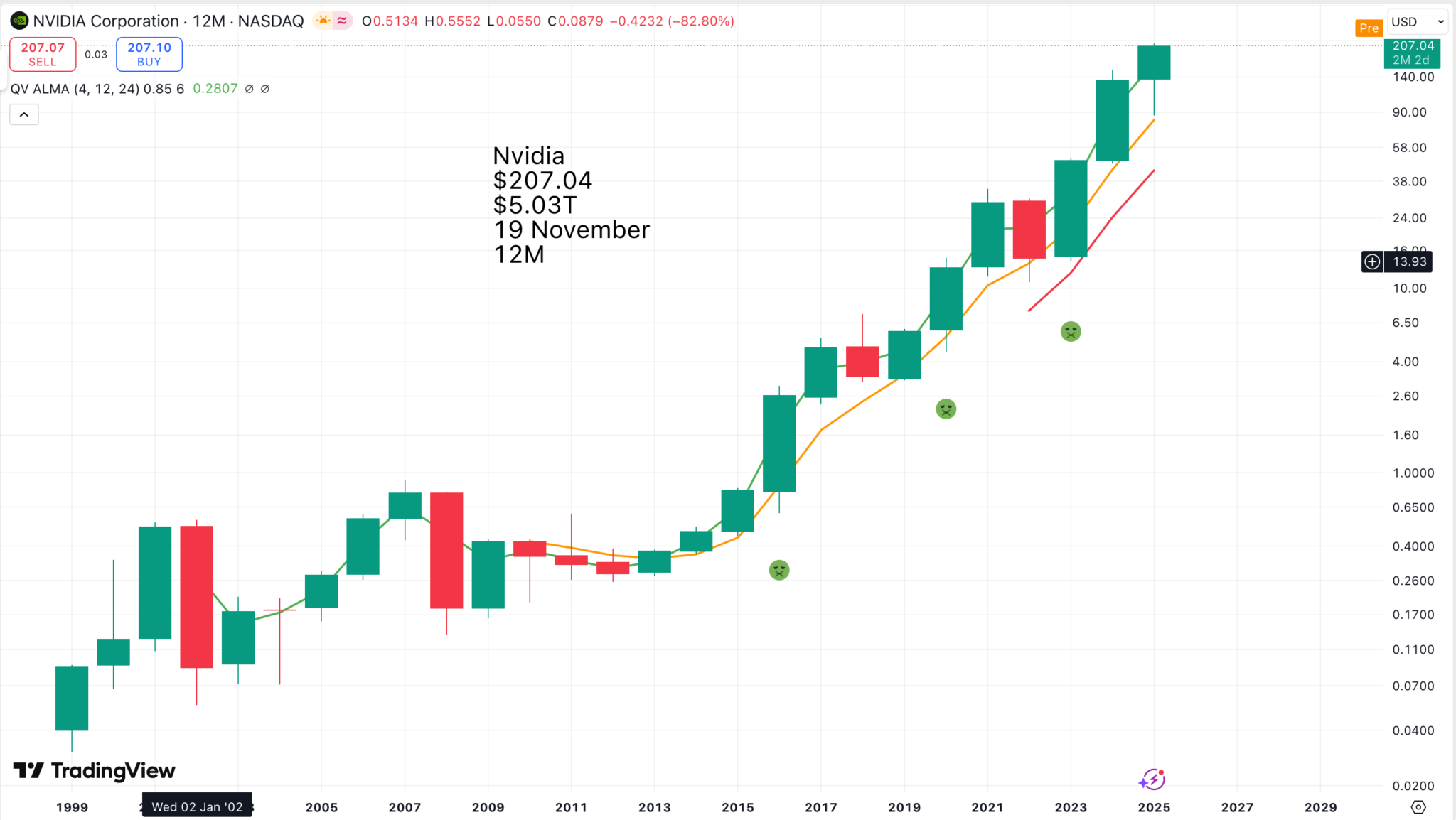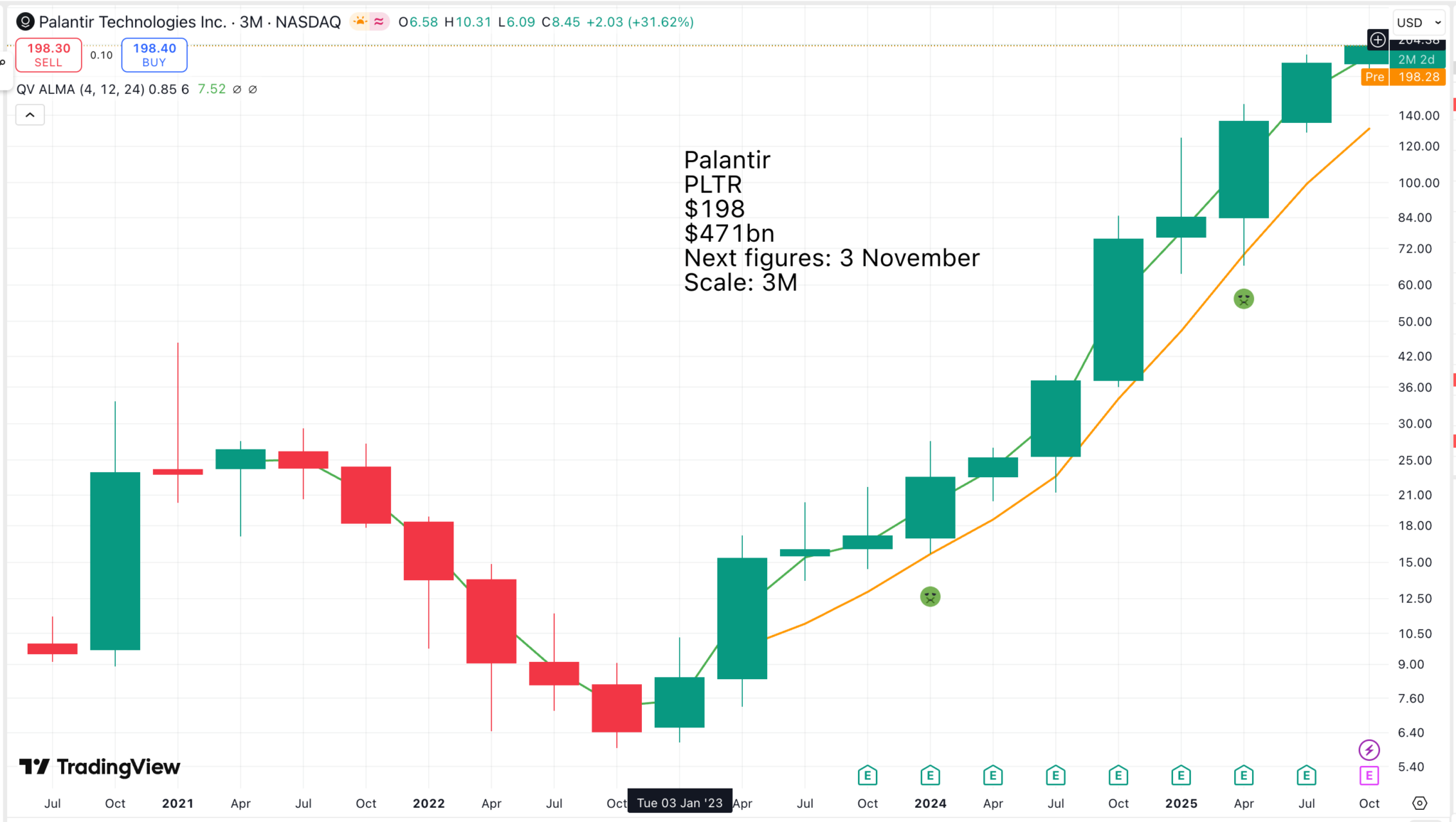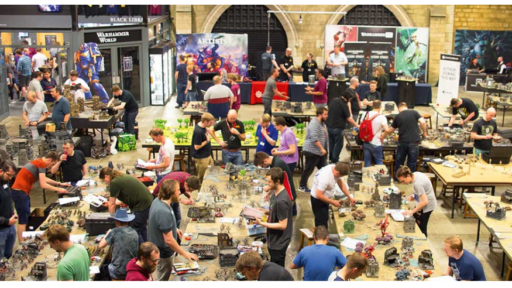

A classic chart for a classic stock. One of the greatest growth stocks of all time and still full of running. If Nvidia is Batman, Palantir is Robin, also with a stunning chart and an incredible story and guess what, they have just done a deal.

NVIDIA today announced a collaboration with Palantir Technologies Inc. to build a first-of-its-kind integrated technology stack for operational AI — including analytics capabilities, reference workflows, automation features and customizable, specialized AI agents — to accelerate and optimize complex enterprise and government systems.
Palantir Ontology, at the core of the Palantir AI Platform (AIP), will integrate NVIDIA GPU-accelerated data processing and route optimization libraries, open models and accelerated computing. This combination of Ontology and NVIDIA AI will support customers by providing the advanced, context-aware reasoning necessary for operational AI.
Enterprises using the customizable technology stack will be able to tap into their data to power domain-specific automations and AI agents for the sophisticated operating environments of retailers, healthcare providers, financial services and the public sector.
“Palantir and NVIDIA share a vision: to put AI into action, turning enterprise data into decision intelligence,” said Jensen Huang, founder and CEO of NVIDIA. “By combining Palantir’s powerful AI-driven platform with NVIDIA CUDA-X accelerated computing and Nemotron open AI models, we’re creating a next-generation engine to fuel AI-specialized applications and agents that run the world’s most complex industrial and operational pipelines.”
“Palantir is focused on deploying AI that delivers immediate, asymmetric value to our customers,” said Alex Karp, cofounder and CEO of Palantir Technologies. “We are proud to partner with NVIDIA to fuse our AI-driven decision intelligence systems with the world’s most advanced AI infrastructure.”
Nvidia newsroom, 28 October 2025
They gave an example of how this partnership will operate.
Lowe’s, among the first to tap this integrated technology stack from Palantir and NVIDIA, is creating a digital replica of its global supply chain network to enable dynamic and continuous AI optimization. This technology can support supply chain agility while boosting cost savings and customer satisfaction.
“Modern supply chains are incredibly complex, dynamic systems, and AI will be critical to helping Lowe’s adapt and optimize quickly amid constantly changing conditions,” said Seemantini Godbole, executive vice president and chief digital and information officer at Lowe’s. “Even small shifts in demand can create ripple effects across the global network. By combining Palantir technologies with NVIDIA AI, Lowe’s is reimagining retail logistics, enabling us to serve customers better every day.”
Nvidia newsroom, 28 October 2025
It is amazing what these guys are doing.
Palantir AIP workloads run in the most complex compliance domains and require the highest standards of privacy and data security. The Ontology at the heart of AIP creates a digital replica of an organization by organizing complex data and logic into interconnected virtual objects, links and actions that represent real-world concepts and their relationships.
Together, this provides enterprises with an intelligent, AI-enabled operating system that drives efficiency through business process automation.
To advance enterprise intelligence for the era of AI, NVIDIA data processing, AI software, open models and accelerated computing are now natively integrated with and available through Ontology and AIP. Customers can use NVIDIA CUDA-X™ data science libraries for data processing, paired with NVIDIA accelerated computing, via Ontology to drive real-time, AI-driven decision-making for complex, business-critical workflows.
The NVIDIA AI Enterprise platform, including NVIDIA cuOpt™ decision optimization software, will enable enterprises to use AI for dynamic supply-chain management.
NVIDIA Nemotron™ reasoning and NVIDIA NeMo Retriever™ open models will enable enterprises to rapidly build AI agents informed by Ontology.
NVIDIA and Palantir are also working to bring the NVIDIA Blackwell architecture to Palantir AIP. This will accelerate the end-to-end AI pipeline, from data processing and analytics to model development and fine-tuning to production AI, using long-thinking, reasoning agents. Enterprises will be able to run AIP in NVIDIA AI factories for optimized acceleration.
Palantir AIP will also be supported in the new NVIDIA AI Factory for Government reference design, announced separately today.
Nvidia newsroom, 28 October 2025
How can anyone not be excited by these businesses? Their shares go up and down as money flies around the stock market with investors operating on so many different time scales, but the direction of travel is UP, UP, UP.
We know all about Alex Karp’s plans to make Palantir the greatest software company in the world, but Nvidia’s ambitions may be even more incredible.
Speaking in Taipei at Asia’s largest electronics expo, CEO Jensen Huang laid out a sweeping vision of the company’s future — one where Nvidia isn’t just enabling AI, it’s helping build a world run by it.
Leading the announcements was the DGX Spark, a compact AI supercomputer built for individual developers, researchers, and students. Think of it as a desktop-sized version of Nvidia’s massive Blackwell-based systems, with enough power to train and fine-tune large AI models locally — no cloud access required.
It’s the plug-and-play engine for what Huang called “AI-native” users — those who want high-performance AI development at their fingertips. Major OEMs such as Dell (DELL), ASUS, Lenovo, MSI, and Gigabyte are already lined up to offer Spark systems tailored for different segments of the market.
That’s just one node in Nvidia’s broader push toward what Huang calls “AI factories” — purpose-built computing environments where massive amounts of data are processed and AI-based systems are created, refined, and deployed.
To support this expansive vision, Nvidia launched something Huang said was “very special” and “one incredible ingredient” that has been missing: NVLink Fusion, an initiative that allows its GPUs to work seamlessly with third-party CPUs and custom AI chips. That means companies such as Qualcomm (QCOM), Fujitsu, Marvell (MRVL), and Alchip Technologies can plug into Nvidia’s ecosystem — a notable shift for a company long known for its tightly integrated stacks.
“I’ll let all of our partners price it for themselves, but one thing’s for sure: Everybody can have one for Christmas,” Huang said.
But this wasn’t just a cloud-computing conversation. It was one about bringing AI into the physical world.
Nvidia doubled down on “physical AI” — the idea that machines should understand and interact with the laws of the real world. Huang talked about Isaac Groot N1 (announced in March), which is a foundational model for robotics that gives humanoid robots the ability to reason, plan, and perceive their surroundings.
“The age of generalist robotics has arrived with breakthroughs in mechatronics, physical AI, and embedded computing — just in time as labor shortages limit worldwide industrial growth,” Huang said.
One challenge in robotics today is data scarcity, especially high-quality, physical interaction data. Nvidia hopes to answer this problem with Cosmos, a photorealistic simulator that creates synthetic data by observing human behavior in virtual environments. Isaac Groot N1, combined with Cosmos, means developers could now create massive amounts of training data in virtual worlds before rolling out systems in the real one.
Developers can now use Groot Dreams — a tool built on Cosmos — to create “future world states,” Huang said, by prompting the model with new tasks and images. This makes it possible to simulate millions of training scenarios before deploying robots in the real world.
To help ground those dreams in physical reality, Nvidia will use the recently announced Newton, an open-source physics engine built in collaboration with Google DeepMind (GOOGL) and Disney Research (DIS) that will be open sourced in July. It’s designed to help AI systems understand real-world dynamics such as gravity, collisions, and torque — bridging the gap between code and physical context.
“It’s incredible what it can do,” Huang said. “It’s completely GPU accelerated. It’s differentiable, so you could learn from experience. It is incredibly high fidelity.”
Meanwhile, Nvidia is planting deeper roots in Asia with Nvidia Constellation, a new AI-focused hub in Taipei’s Beitou Shilin Science Park. It’s a strategic play — tapping into Taiwan’s world-class semiconductor ecosystem while deepening Nvidia’s presence in the global AI supply chain.
Taipei’s mayor, Chiang Wan-an, attended Huang’s keynote and later told reporters that the city fully supports Nvidia’s plans and is ready to offer whatever help is needed.
One of the most strategically significant announcements came near the close of Huang’s keynote: a joint effort to build a national AI supercomputer in Taiwan. Nvidia will partner with Taiwan Semiconductor Manufacturing Company (TSM) (TSMC), Foxconn, and the Taiwanese government to create a cutting-edge AI system for the island.
This project aims to integrate AI deeply into urban infrastructure, transforming cities such as Taipei into smart ecosystems powered by advanced computing. The initiative underscores Nvidia’s goal of embedding AI — and thus, its products — into the fabric of daily life, from autonomous vehicles to intelligent public services.
Huang’s overall message was unmistakable: AI is no longer just software. It’s infrastructure. It’s automation. It’s everywhere. And Nvidia wants to not only build just the silicon — it wants to build but the systems, the software, and the global footprint to power it all.
Quartz, 19 May 2025
The issue which is continually referenced with Palantir is the valuation. This has not been a helpful guide to price action in the past. It is not about the details with Palantir, but the big picture. The AI boom is enabling companies to grow at insane rates. OpenAI launched ChatGPT on November 30, 2022, and gained a million users in the first week. It currently has an estimated 845 million users, including 10 million paying subscribers and 1 million users on the commercial plan. Rumour has it that OpenAI is planning an IPO next year, valuing the business at $1 trillion. If true, this will all have happened in less than four years.
Do you imagine that, in early 2023, any value investors saw that coming? OpenAI is a wonderful business at the heart of AI, and as well as Sam Altman as CEO, it has my favourite lady, Sarah Friar, as CFO. She is deservedly becoming a Silicon Valley legend, and I can’t wait to hear her tell the world why OpenAI is such an amazing company.
Palantir is also a wonderful business, and Alex Karp is another Silicon Valley legend with huge plans for his business. The value guys will never get this one, just as they miscalled the early years of Nvidia. Almost to a man, they said Nvidia was a cyclical semiconductor stock that was wildly overpriced. A few years later, they have quietly forgotten all those misjudgements, but they are still struggling with Palantir.
I don’t have a problem because I am not a value investor. I like stories, I like excitement, I like guys and girls with huge plans, and I like the romance of companies that are aiming for the moon and delivering on their promises.
I also like guys who agree with me.
Momentum can be one of the most powerful forces in the market. Sometimes, it can very well trump what the fundamentals may say. As investors, I understand that it can be difficult to watch a stock soar purely on sentiment while its valuation metrics look stretched, going by the conventional benchmarks. But sometimes, as history proves time and time again, the biggest wins can very well come from stocks riding a wave of narrative, visibility, and clear growth catalysts, even if their fundamentals seemed “too rich” at the time.
In my eyes, Palantir Technologies Inc. (PLTR) seems exactly like one of those cases, in which momentum and strategic positioning come together to create the conditions for a massive price expansion.
Palantir will be releasing its Q3 earnings next week, on Monday, November 3rd, and there seems to be a lot of bullish anticipation from the market. This can be gauged clearly from the strong run up the stock is experiencing, jumping from $175 to the $190 mark, in just three days. This movement alone has added $33 billion to the company’s market cap in a very short time, with the stock now trading at an all-time high.
In this analysis, I highlight my thoughts on the upcoming Q3 earnings, and why Palantir is likely to deliver a standout quarter, and beat expectations significantly. Its recent partnership expansions and government contract wins massively reinforce its strategic significance as a critical player in the AI landscape. More importantly, I believe that these wins will help the management lay out a very compelling long-term narrative that justifies current multiples, and will fuel further price climbs.
Seeking Alpha, Weebler Finance, 28 October 2025
The author cites deals with the UK and Poland, which he thinks will position Palantir as a major supplier to NATO. It is already well-established with the US government and refuses to have anything to do with perceived enemies of the West.
Its commercial business is also roaring ahead, as is likely to be confirmed when the company reports Q3 2025 results on Monday, 3 November. You never know what shares are going to do when companies report. Even when the news is good, the price can be all over the place. The big picture, though, is that both Nvidia and Palantir are key players in the global technology revolution, and this revolution is proceeding at an incredible rate.
Share Recommendations
Nvidia. NVDA
Palantir. PLTR



